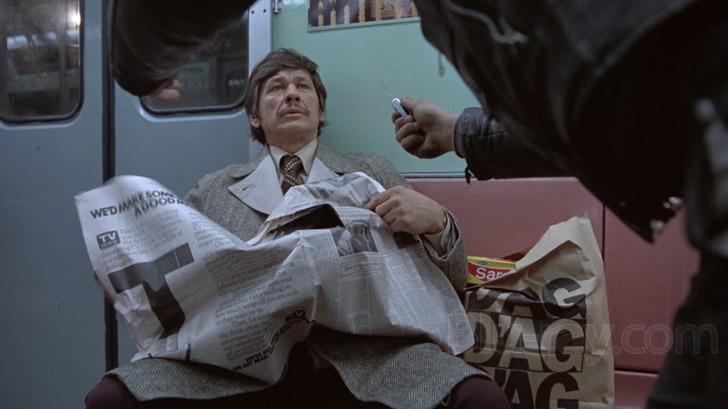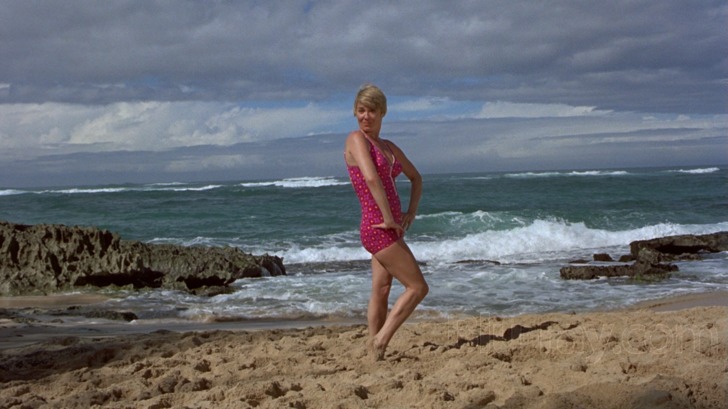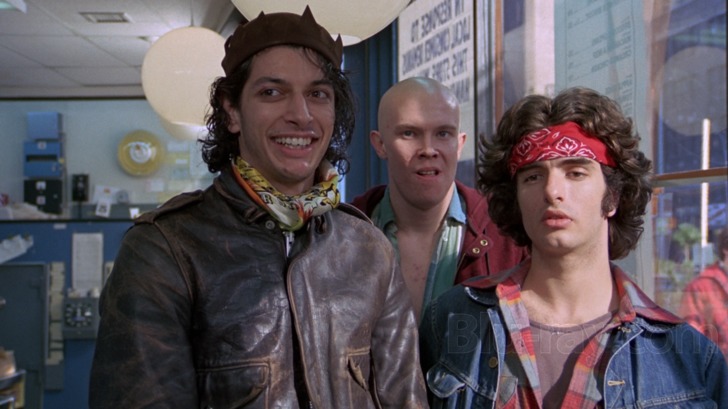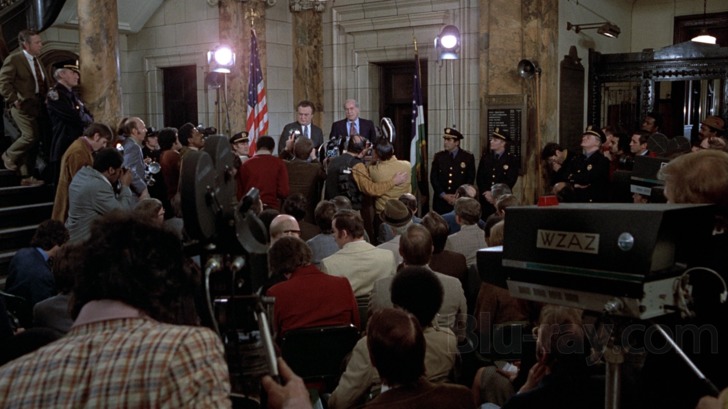Death Wish Blu-ray Movie
HomeDeath Wish Blu-ray Movie 
Warner Bros. | 1974 | 93 min | Rated R | Feb 04, 2014
Movie rating
7.3 | / 10 |
Blu-ray rating
| Users | 3.8 | |
| Reviewer | 4.0 | |
| Overall | 3.8 |
Overview
Death Wish (1974)
A New York City architect becomes a one-man vigilante squad after his wife is murdered by street punks.
Starring: Charles Bronson, Hope Lange, Vincent Gardenia, Steven Keats, William RedfieldDirector: Michael Winner
| Crime | Uncertain |
| Thriller | Uncertain |
| Drama | Uncertain |
| Action | Uncertain |
Specifications
Video
Video codec: MPEG-4 AVC
Video resolution: 1080p
Aspect ratio: 1.78:1
Original aspect ratio: 1.85:1
Audio
English: DTS-HD Master Audio 2.0 Mono (48kHz, 24-bit)
Spanish: Dolby Digital 2.0 Mono
French: Dolby Digital 2.0 Mono
Subtitles
English SDH, French, Spanish
Discs
25GB Blu-ray Disc
Single disc (1 BD)
Playback
Region free
Review
Rating summary
| Movie | 4.0 | |
| Video | 4.5 | |
| Audio | 4.0 | |
| Extras | 0.5 | |
| Overall | 4.0 |
Death Wish Blu-ray Movie Review
Kersey's Way
Reviewed by Michael Reuben January 26, 2014The vigilante classic Death Wish is a cultural landmark, a cinematic journal of America's worst nightmares in the era immediately after Vietnam. Don Siegel and Clint Eastwood provided a preview three years earlier in Dirty Harry, which involved a good cop who concluded that "the law is crazy" and the system protected criminals better than the public. At the end of Dirty Harry, Inspector Callahan threw away his badge in disgust, but the character proved so popular that he was brought back two years later in Magnum Force, still a cop, still trying to work within the system (indeed, so much so that he became a target of renegades from his own department). For a full and complete expression of just how seriously law and order seemed to be breaking down at the time, the story had to be told from a victim's point of view, someone who had been so thoroughly abandoned by the criminal justice system that self-help was the only option. Brian Garfield's novel Death Wish appeared in 1972 and was quickly acquired by producer Dino De Laurentiis. Wendell Mayes (Anatomy of a Murder) freely adapted the story for the screen. At one point, Sidney Lumet was attached as a director, but Lumet decided to make Serpico instead. It would have been interesting to see how Lumet, with his gift for exploring moral complexity, would have framed the story, especially since Jack Lemmon was slated to play the lead at the time. But Lemmon dropped out after Lumet's departure, and the film became the fourth collaboration between British director Michael Winner and star Charles Bronson. Despite negative reviews—"revulsion" would not be too strong a characterization—the film resonated with audiences, and the character of avenging citizen Paul Kersey became Bronson's signature role. He and Winner would make two sequels together, and Bronson would make two more with other directors. But none of them equaled the power of the original, which traces Kersey's arc from mild-mannered, lawful citizen to remorseless urban gunslinger. (In the sequels, Kersey is merely a killer in hiding, waiting for the inevitable call to action.)

Death Wish has a simple story. A successful New York City architect, Bronson's Paul Kersey, is happily married to a "girl next door" wife, Joanna (Hope Lange), and has a grownup daughter, Carol (Kathleen Tolan), who is happily married to a dutiful son-in-law, Jack Toby (Steven Keats). One day, after Joanna and her daughter have been out shopping, they are brutally attacked in the Kerseys' apartment by three vicious punks, one of whom is played by a youthful Jeff Goldblum in his first film appearance. The scene echoes the attack on the writer and his wife in Kubrick's A Clockwork Orange, but it's less stylized and more realistic (which is, in many ways, much worse). Joanna doesn't survive, and Carol is so traumatized that she stops speaking and requires round-the-clock care. After the NYPD tells Kersey that there is little chance of catching the perpetrators, he gradually reconsiders his stance on violence, until one night he finds himself entering Riverside Park with a pistol in his coat. Using himself as bait, he begins gunning down muggers—and so intimidates the city's criminal element that the mugging rate falls by more than half in a matter of weeks. What makes Death Wish compulsively watchable, even today, is the precise detail with which Winner and Bronson trace Kersey's conversion, even though Bronson plays him in the stoic, minimalist style perfected by Clint Eastwood (who was reportedly offered the part at one point). The effect is to keep viewers' eyes glued to Kersey, wondering what is going on just beneath the surface, as he buries himself in work, trying to hide from unbearable loss and grief. His partners send him to Tucson, Arizona, to meet with a difficult client, Aimes Jainchill (Stuart Margolin), where Kersey redesigns a development to suit both the client and the builders. (In modern parlance, we might say he makes it "green".) But the real accomplishment of his trip isn't the successful design; it's the visit to a gun club, where Aimes takes Kersey for a break from work and where Kersey's old military training resurfaces. When Kersey returns to New York, Aimes has given him the gift of a revolver, and he is now fully equipped to become a citizen avenger. Once Kersey's reign of terror begins, the reaction of the authorities is ambivalent. Police Inspector Ochoa (the excellent Vincent Gardenia) shows a flair for imaginative leads, as well as a flexible attitude toward the Fourth Amendment. (One gets the sense that, if Ochoa ran the Department, crime would be dealt with more aggressively.) But the closer Ochoa gets to Kersey, the more his superiors pull him back. Kersey's one-man crusade has captured the public's imagination and produced results. The last thing the authorities need is to make a martyr out of someone who's proven himself more effective at protecting the public than they have.
Death Wish Blu-ray Movie, Video Quality 

Cinematographer Arthur J. Ornitz shot Death Wish for director Winner shortly after finishing Serpico for Sidney Lumet. Despite similar locales and subject matter, the two films have completely different visual styles. Serpico reflects grit and urban decay, whereas Death Wish is less realistic in evoking the asphalt jungle. (Just as an example, the subway car where Paul Kersey stages one of his ambushes is remarkably free of graffiti.) Instead, Ornitz lights the frame for the richer texture of a nightmare, especially in the dark nighttime sequences where Kersey confronts the demons haunting the city. Warner's 1080p, AVC-encoded Blu-ray is another fine release under its licensing deal with Paramount. The source material is in excellent shape (or has been well-restored), detail is first-rate, and the film's grain pattern appears natural and undisturbed by untoward digital manipulation. Blacks are rich and deep, and the remainder of the color spectrum is fully represented, especially in those portions of the film set outside New York (Tucson in mid-film, Hawaii at the beginning). The contrast levels in snowy scenes outdoors (e.g., the funeral) have been perfectly set to bring out detail without overwhelming it. The film serves as a visual scrapbook not only of how America's biggest city looked in the early Seventies, but also of how people felt about it, before effective policing, economic recovery and TV shows like Seinfeld completely changed its public persona. The 93-minute film occupies a BD-25, but there are no extras, and Warner has achieved a high (for them) average bitrate of 26.56 Mbps. The image is stable and free of artifacts.
Death Wish Blu-ray Movie, Audio Quality 

The original mono soundtrack for Death Wish is presented as lossless DTS-HD MA 2.0, with identical left and right channels. Herbie Hancock's atmospheric and often unsettling score would no doubt sound better in a stereo presentation, if original stems are available, but it has decent presence and fidelity in this rendition of the original mono mix. Dialogue is clear, and sound effects have the appropriate impact, with gunshots loud but not too loud. (Bronson's Kersey isn't the Terminator; in fact, the opposite.)
Death Wish Blu-ray Movie, Special Features and Extras 

Other than a trailer (480i; 1.78:1; 2:26), the disc contains no extras. Paramount's 2001 DVD also contained no extras other than a trailer.
Death Wish Blu-ray Movie, Overall Score and Recommendation 

Death Wish traces the tragic transformation of a gentle man into a killer who deliberately dares criminals to harm him because (as the title suggests) he no longer feels he has anything to lose. Novelist Brian Garfield objected that the film glorified violence, despite Bronson's insistence to the contrary, and that was certainly true of the film's sequels, in which Paul Kersey's goodness became little more than a disguise for his true nature, and his vigilante became a hunter seeking prey. But in the original Death Wish, Kersey remains as much a victim of violence as his family, and Winner's closing shot lets us know that the damage is permanent. Highly recommended.
Other editions
Death Wish: Other Editions
Similar titles
Similar titles you might also like

The Stone Killer
Limited Edition to 3000
1973

Death Wish 3 4K
1985

The Exterminator
Unrated Director`s Cut
1980

Death Wish II 4K
Slipcover in Original Pressing
1982

Death Wish V: The Face of Death
1994

I Spit on Your Grave 4K
Day of the Woman
1978

Death Wish 4: The Crackdown
1987

A Kind of Murder
2016

Assault on Precinct 13
Collector's Edition
1976

The Enforcer
The Dirty Harry Collection
1976

Sudden Impact
The Dirty Harry Collection
1983

Brawl in Cell Block 99 4K
2017

Ms .45 4K
Limited Edition
1981

Exterminator 2
1984

Avenging Angel
1985

Defiance
1980

10 to Midnight
Collector's Edition
1983

Cruising 4K
Limited Edition
1980

Coffy
1973

Maniac Cop 2
1990



